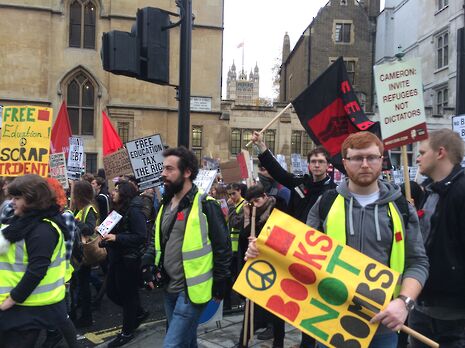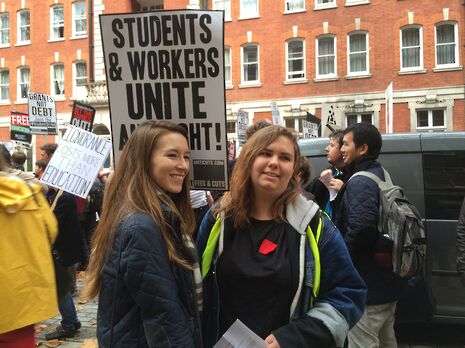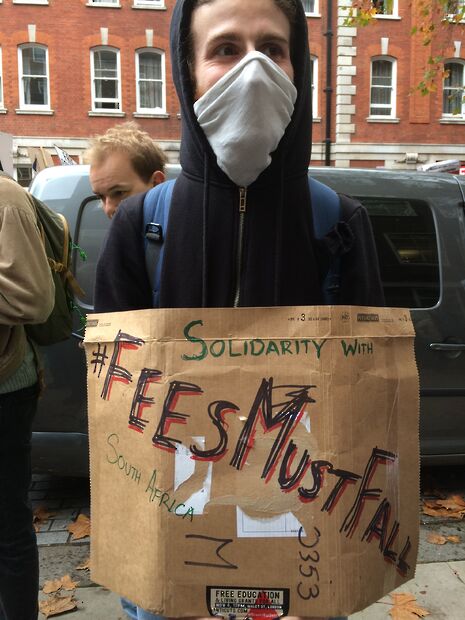Reflections on the Revolution in London
Joe Robinson took to the barricades on Wednesday alongside a Cambridge contingent heading to the Free Education protest

Talking to a brick wall is an idiom often applied to the interactions of the governed with the governing to depict governments as intransigent or willfully ignorant. Seldom, though, is it literally true. On Wednesday, however, at the National Demonstration for Free Education in London, I was struck by how aptly it described the day’s events both. As the march reached its climax outside the Department for Business, Innovation and Skills – the government department which is, perplexingly, responsible for universities – the limitations of direct action were laid bare.
Their chants met the glass and steel façade of the office block and reverberated back at them. Neither Sajid Javid, the department’s Secretary of State, nor David Cameron, against whom much abuse throughout the day had been directed, would hear, let alone take seriously, a word of what was being said. Ensconced in the Westminster Bubble, protected by a slim parliamentary majority and the security of another five years in office, they had, and have, no incentive to change policy. The demonstrators’ chant that “The people, united, will never be defeated” could just as well apply to the democratic will of the British people, who returned the first majority Conservative government in the lifetimes of many of the protestors. Despite the homemade cardboard banners, now soggy, which flopped in the mild breeze, the vigour of the chanting and the intensity of their moral indignation, their efforts will likely be ultimately futile.

But this is just a small part of the wider picture. Dismissing these efforts would be to fail to do justice to the students who voluntarily dedicated so many resources and so much time to make their voices heard. What marched on Wednesday was not a collection of students but a unified movement, which must surely, in this age of political factionism, command some admiration. There was something admirable in the earnest purity of their radicalism. Though the demonstration did not register on the conventional political scale, it was seismic in terms of student direct action. Though I remain sceptical not only of the viability of ‘free education’ but also of the efficacy of direct action, and despite the demo’s uglier elements, there was something intangibly and earnestly virtuous about the demonstration.
As the fifteen or so Cambridge and ARU students assembled on a rainy Wednesday morning on Queens’ Backs, you wouldn’t have thought that the British Left was in crisis. A palpable camaraderie suffused the group, and people bonded over a shared political viewpoint – discussions about Marxist reading groups, socialist youth camps and previous years’ protests abounded. During the coach journey, funded and put on by CUSU, small squares of red felt were distributed, to be attached to our clothes. Borrowed from student protests against tuition fee hikes in Quebec, this was a sign of solidarity with the ‘free education’ movement. As it later became apparent, however, I was practically the only student participating in the protest who was wearing a poppy – other students were more content to cover their faces or display their felt squares in full view. The reason why no other students did so, and opted for the red square, I was told, was because wearing a poppy indicated support for “British militarism”. Never mind the fact that Jeremy Corbyn wears a poppy or the fact that the proceeds of the Poppy Appeal go to the Royal British Legion and not the defence budget, it became clear that many of those protesting were sceptical of authority in all of its forms.

The website for the entity organising the rally, the National Campaign Against Fees and Cuts (NCAFC), states that the police are the “bearers of violence” who are “not [the] protectors of peace”. While such an intense sentiment was never explicitly restated by those on the coach, echoes of such scepticism were evident. On the coach, the claim that the “police are there in theory to look after you” was met by a chuckle that masked a deeply ingrained distrust of the police. When ‘bust cards’ with legal advice were handed out and marker pens were distributed to write solicitors’ numbers on our arms in case of arrest, I wondered what I was in for.
The truth is that this concern with police violence was borne out by the considerable police presence in London. I witnessed a procession of riot vans, areas of Whitehall cordoned off and mounted police typically reserved for major sporting occasions. Everywhere I looked I saw several police officers, some of them community support officers, some of them police liaisons and some of them regular bobbies. Although it is perhaps natural that the student protesters would be suspicious of the police presence, the allegations that I heard, including that the police were there to ‘gather information’ on protestors, would have seemed to befit a terrorist cell more than a peaceful demonstration. Nor was the atmosphere helped by the setting off of flares, or chants that included “Justice, no peace. Fuck the police!” How exactly, I was left wondering, does that further the cause of free education?
On the whole, however, the demonstration remained a peaceful exercise in direct action. As the assembled wormed their way around Russell Square, through Covent Garden, down Whitehall and around Westminster, what was in evidence was a democratic exercise in protest. I kept returning to the fact that I suspected little to nothing would come of this demonstration, save perhaps ephemeral coverage in the press.

Students I spoke to were enthusiastic about direct action, with one proclaiming that “politics is in the streets” and holding the scale of the demonstration as evidence of its efficacy. One Cambridge student I spoke to, who had experience of the events in South Africa – where direct action led to a marked reduction in tuition fees – rated direct action’s capacity for change above that of parliamentary democracy. He questioned whether change could ever be achieved through democratic means, and argued that the suffragettes had shown that direct action must precede any change in official policy. When asked what the function of the demonstration was, besides aiming to influence policy, another student remarked that they hoped to “meet people and network”. The whiff of champagne socialism hung briefly in the air.
My strong suspicion is that, when the inability of the demonstration to change anything substantive is laid bare, its purpose is akin to group therapy, writ large. It consisted of the articulation of shared frustrations on the part of students who simultaneously abhor Conservative policy and yet are powerless to change it. Powerlessness led to a loss of focus, as cuts- and grants-related chants give way to oinking noises and “Where are you, Cameron?”. From refugee-related chants, including “Immigrants, here to stay. Let’s deport Theresa May!”, to an incisive commentary on David Cameron’s allegations of animal husbandry, the protest began to deviate from its stated theme. Neither big nor clever, really.
 News / Cambridge study finds students learn better with notes than AI13 December 2025
News / Cambridge study finds students learn better with notes than AI13 December 2025 News / Cambridge Vet School gets lifeline year to stay accredited28 November 2025
News / Cambridge Vet School gets lifeline year to stay accredited28 November 2025 Science / Did your ex trip on King’s Parade? The science behind the ‘ick’12 December 2025
Science / Did your ex trip on King’s Parade? The science behind the ‘ick’12 December 2025 News / Uni Scout and Guide Club affirms trans inclusion 12 December 2025
News / Uni Scout and Guide Club affirms trans inclusion 12 December 2025 Arts / Modern Modernist Centenary: T. S. Eliot13 December 2025
Arts / Modern Modernist Centenary: T. S. Eliot13 December 2025









